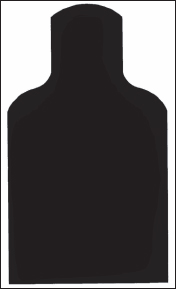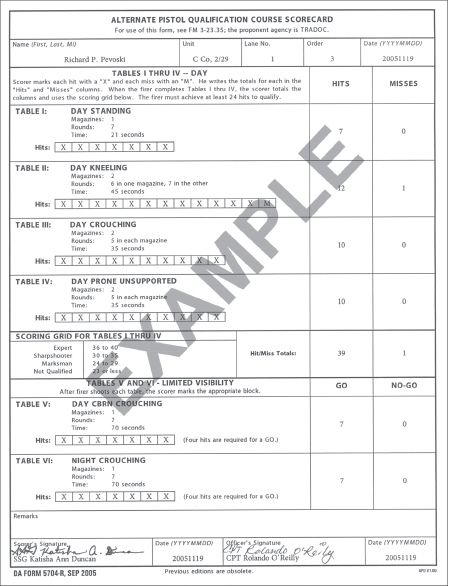 EXPERT: 36 to 40 hits.
EXPERT: 36 to 40 hits.Once the Soldier completes instructional fire, he must complete the Combat Pistol Qualification Course (CPQC) for the record. However, when the CPQC is unavailable, the Alternate Pistol Qualification Course (APQC) may be used.
The tower operator is completely responsible for and in charge of the range and the course. He controls absolutely all activities related to firing. The tower operator tells the scorers what to do when, for example, when to issue the preloaded magazines to firers. Only the tower operator may issue the order to fire. Scorers and firers must await the tower operator’s orders.
The firer is given 40 rounds of ammunition for Tables I through IV and 14 rounds for Tables V and VI:
a. Table I–Day Standing. Within 21 seconds, engage the 25-meter APQC target from the standing position with 7 rounds of ammunition; given one 7-round magazine during daylight hours.
b. Table II–Day Kneeling. Within 45 seconds, engage the 25-meter APQC target from the kneeling position with 13 rounds during hours of daylight. From a standing position, assume a good kneeling position, engage the target with 6 rounds, perform a rapid magazine change, and engage the target with 7 rounds.
c. Table III–Day Crouching. Within 35 seconds, engage the 25-meter APQC target from the crouching position with 10 rounds; given two magazines with 5 rounds each during daylight hours. From a standing position, assume a good crouching position, engage the target with one 5-round magazine, perform a rapid magazine change, and engage the target with the second 5-round magazine.
d. Table IV–Day Prone. Within 35 seconds, engage the 25-meter APQC target from the prone position with 10 rounds; given two magazines with 5 rounds each during daylight hours. From a standing position, assume a good prone position, engage the target with one 5-round magazine, perform a rapid magazine change, and engage the target with the second 5-round magazine.
e. Table V–Day CBRN Crouching. Within 70 seconds, engage the 25-meter target from the crouching position with 7 rounds; given one 7-round magazines under simulated CBRN conditions.
f. Table VI–Night Crouching. Within 70 seconds, engage a 25-meter target from a crouching position with 7 rounds; given one 7-rounds magazine under night conditions.
Commands shape the conduct of range fire in the APQC. When the firer uses a 9-mm pistol, he fires the first round in each table in double-action mode. At the end of each firing table, he returns excess ammunition to the scorer. He may not use it in other firing tables. At the end of the course, the scorer returns all excess ammunition to the ammunition point.
| NOTES: |
1. Commanders may use the Engagement Skills Trainer (EST) 2000 for Tables V (Day CBRN Crouching) and VI (Night Crouching). |
|
2. Only the tower operator may give firing instructions. |
a. Table I–Day Standing. The tower operator gives the order to move to the firing line and to prepare to fire. On the tower operator’s command, the scorer issues to the firer one magazine containing seven rounds.
(1) The tower operator then commands:
TABLE ONE, STANDING POSITION, SEVEN ROUNDS.
LOAD AND LOCK. ONE SEVEN ROUND MAGAZINE.
IS THE FIRING LINE READY? (Firers using 9-mm pistols place them on double-action.)
READY ON THE RIGHT.
READY ON THE LEFT.
THE FIRING LINE IS READY.
FIRERS, UNLOCK YOUR WEAPONS.
FIRERS, WATCH YOUR LANE!
(2) At the end of the prescribed firing time, the tower operator commands:
CEASE FIRE.
ARE THERE ANY ALIBIS? (Alibis get eight seconds for each round not fired.)
UNLOAD AND CLEAR ALL WEAPONS.
IS THE FIRING LINE CLEAR?
CLEAR ON THE RIGHT.
CLEAR ON THE LEFT.
THE FIRING LINE IS NOW CLEAR.
FIRERS, PLACE YOUR WEAPON ON THE STANDS WITH SLIDES LOCKED TO THE REAR.
FIRERS AND SCORERS, MOVE DOWNRANGE AND CHECK YOUR TARGETS.
MARK AND COVER ALL HOLES.
b. Table II–Day Kneeling. The tower operator orders firers to move up to the firing line. On the tower operator’s command, the scorer issues two magazines, one loaded with six rounds and the other with seven, to the firer.
(1) The tower operator then commands:
TABLE TWO, KNEELING POSITION, SIX ROUNDS.
LOAD AND LOCK ONE SIX-ROUND MAGAZINE.
LOAD YOUR SEVEN-ROUND MAGAZINE WITHOUT COMMAND.
IS THE FIRING LINE READY? (Firers using 9-mm pistols place them on double action.)
READY ON THE LEFT.
READY ON THE RIGHT.
THE FIRING LINE IS READY.
FIRERS, UNLOCK YOUR WEAPONS.
FIRERS, WATCH YOUR LANES.
(2) The tower operator then commands:
CEASE FIRE.
ARE THERE ANY ALIBIS? (Alibis get eight seconds for each round not fired.)
UNLOAD AND CLEAR ALL WEAPONS.
IS THE FIRING LINE CLEAR?
CLEAR ON THE RIGHT CLEAR ON THE LEFT THE FIRING LINE IS NOW CLEAR.
FIRERS, PLACE YOUR WEAPON ON THE STANDS WITH SLIDES LOCKED TO THE REAR.
FIRERS AND SCORERS MOVE DOWNRANGE AND CHECK YOUR TARGETS.
MARK AND COVER ALL HOLES.
c. Table III–Day Crouching. The tower operator orders firers to move to the firing line.
(1) On the tower operator’s command, the scorer issues two five-round magazines to the firer:
TABLE THREE, CROUCHING POSITION, FIVE ROUNDS.
LOAD AND LOCK ONE FIVE-ROUND MAGAZINE.
IS THE FIRING LINE READY? (Firers using 9-mm pistols place them on double action.)
READY ON THE RIGHT.
READY ON THE LEFT.
THE FIRING LINE IS READY.
FIRERS, WATCH YOUR LANES.
(2) At the end of the prescribed firing time, the tower operator commands:
CEASE FIRE.
ARE THERE ANY ALIBIS? (Alibis are given 10 seconds for each round not fired.)
UNLOAD AND CLEAR ALL WEAPONS.
IS THE FIRING LINE CLEAR?
CLEAR ON THE RIGHT.
CLEAR ON THE LEFT.
THE FIRING LINE IS NOW CLEAR.
FIRERS, PLACE YOUR WEAPON ON THE STAND WITH SLIDES LOCKED TO THE REAR.
FIRERS AND SCORERS, MOVE DOWNRANGE AND CHECK YOUR TARGETS.
MARK AND COVER ALL HOLES.
d. Table IV–Day Prone Unsupported. The tower operator orders firers to move to the firing line. On the tower operator’s command, the scorer issues two five-round magazines to the firer.
(1) After the firer completes Table IV, the scorer and firer repair or replace targets for the next firing order:
TABLE FOUR, PRONE POSITION, FIVE ROUNDS.
LOAD AND LOCK ONE FIVE-ROUND MAGAZINE.
LOAD YOUR SECOND FIVE-ROUND MAGAZINE WITHOUT COMMAND.
IS THE FIRING LINE READY?
READY ON THE RIGHT.
READY ON THE LEFT.
THE FIRING LINE IS READY.
FIRERS, UNLOCK YOUR WEAPONS.
FIRERS, WATCH YOUR LANES.
(2) At the end of the prescribed firing time, the tower operator commands:
CEASE FIRE.
ARE THERE ANY ALIBIS? (Alibis are given 10 seconds for each round not fired.)
UNLOAD AND CLEAR ALL WEAPONS.
IS THE FIRING LINE CLEAR?
CLEAR ON THE RIGHT.
CLEAR ON THE LEFT.
THE FIRING LINE IS NOW CLEAR.
FIRERS, PLACE YOUR WEAPON ON THE STAND WITH SLIDES LOCKED TO THE REAR.
FIRERS AND SCORERS, MOVE DOWN RANGE AND CHECK YOUR TARGETS.
MARK AND COVER ALL HOLES.
e. Table V–Day CBRN Crouching. All firers wear protective masks with hoods. The tower operator orders firers to move to the firing line. On the tower operator’s command, the scorer issues one seven-round magazine to the firer.
(1) Again, he issues the same commands he did for Table I.
TABLE FIVE, CBRN FIRE, CROUCHING POSITION, SEVEN ROUNDS.
LOAD AND LOCK ONE MAGAZINE.
IS THE FIRING LINE READY? (Firers using 9-mm pistols place them on double-action.)
READY ON THE RIGHT.
READY ON THE LEFT.
THE FIRING LINE IS READY.
FIRERS, WATCH YOUR LANES.
(2) At the end of the prescribed firing time, the tower operator commands:
CEASE FIRE.
ARE THERE ANY ALIBIS? (Alibis are given 10 seconds for each round not fired.)
UNLOAD AND CLEAR ALL WEAPONS.
IS THE FIRING LINE CLEAR?
READY ON THE RIGHT.
READY ON THE LEFT.
THE FIRING LINE IS NOW CLEAR.
FIRERS, PLACE YOUR WEAPON ON THE STAND WITH SLIDES LOCK TO THE REAR FIRERS AND SCORERS, MOVE DOWNRANGE AND CHECK YOUR TARGETS.
MARK AND COVER ALL HOLES.
f. Table VI–Night Crouching. The tower operator orders firers to move to the firing line and to prepare to fire. On the tower operator’s command, the scorer issues one seven-round magazine to the firer.
(1) The tower operator commands:
TABLE SIX, NIGHT FIRE, CROUCHING POSITION, SEVEN ROUNDS.
LOAD AND LOCK ONE MAGAZINE.
IS THE FIRING LINE READY? (Firers using 9-mm pistols place them on double-action.)
READY ON THE RIGHT.
READY ON THE LEFT.
THE FIRING LINE IS READY.
FIRERS, UNLOCK YOUR WEAPONS.
FIRERS, WATCH YOUR LANES.
(2) At the end of the prescribed firing time, the tower operator commands:
CEASE FIRE.
ARE THERE ANY ALIBIS? (Alibis get 8 seconds for each round not fired.)
UNLOAD AND CLEAR ALL WEAPONS.
IS THE FIRING LINE CLEAR?
READY ON THE RIGHT.
READY ON THE LEFT.
THE FIRING LINE IS NOW CLEAR.
FIRERS, PLACE YOUR WEAPONS ON THE STANDS WITH SLIDES LOCKED TO THE REAR.
FIRERS AND SCORERS, MOVE DOWNRANGE AND CHECK YOUR TARGETS.
MARK AND COVER ALL HOLES.
The scorer reports and records any weapon or target malfunction that occurs during fire. The firer is allowed one alibi at the end of each table. For Tables I through IV, he is allowed 8 seconds for each alibi. For Tables V and VI, he is allowed 10 seconds each. All alibis are fired where the malfunction occurred, and the same firing commands are used.
Figure B-1 shows a 25–meter E-type silhouette. Figure B-2 shows an example completed DA Form 5704-R (Alternate Pistol Qualification Course Scorecard). A blank copy is provided in the back of the book. The blank form may be reproduced locally on 8 1/2- by 11-inch paper. It may also be downloaded from the Internet at Army Knowledge Online (http://www.army.mil/usapa/eforms/).
a. Firing Tables I thru IV. Each time a firer hits or kills a target, the scorer places an “X” (for a hit) or “M” (for a miss) in the appropriate box, then writes the number of each in the “Hits” and “Misses” columns to the right. After the firer completes the first four firing tables, the scorer tallies the total hits and misses and uses the scoring grid to determine if the firer qualified on those four tables.
 EXPERT: 36 to 40 hits.
EXPERT: 36 to 40 hits.
 SHARPSHOOTER: 30 to 35 hits.
SHARPSHOOTER: 30 to 35 hits.
 MARKSMAN: 24 to 29 hits.
MARKSMAN: 24 to 29 hits.
 UNQUALIFIED: 0 to 23 hits.
UNQUALIFIED: 0 to 23 hits.
b. Firing Tables V and VI. Each time a firer hits or kills a target, the scorer places an “X” (hit) or “M” (miss) in the appropriate box. Then, he writes the total number of hits and misses in the columns to the right. The firer must hit four targets in each table in order to receive a “GO” on that table.
During instructional fire, the coach and assistant instructors should help the firer correct errors. However, during record fire, no one may help or try to help the firer while or after he takes his position at the firing point.

Figure B-1. E-type silhouette, 25-meter, without rings.

Figure B-2. Example completed DA Form 5704-R.